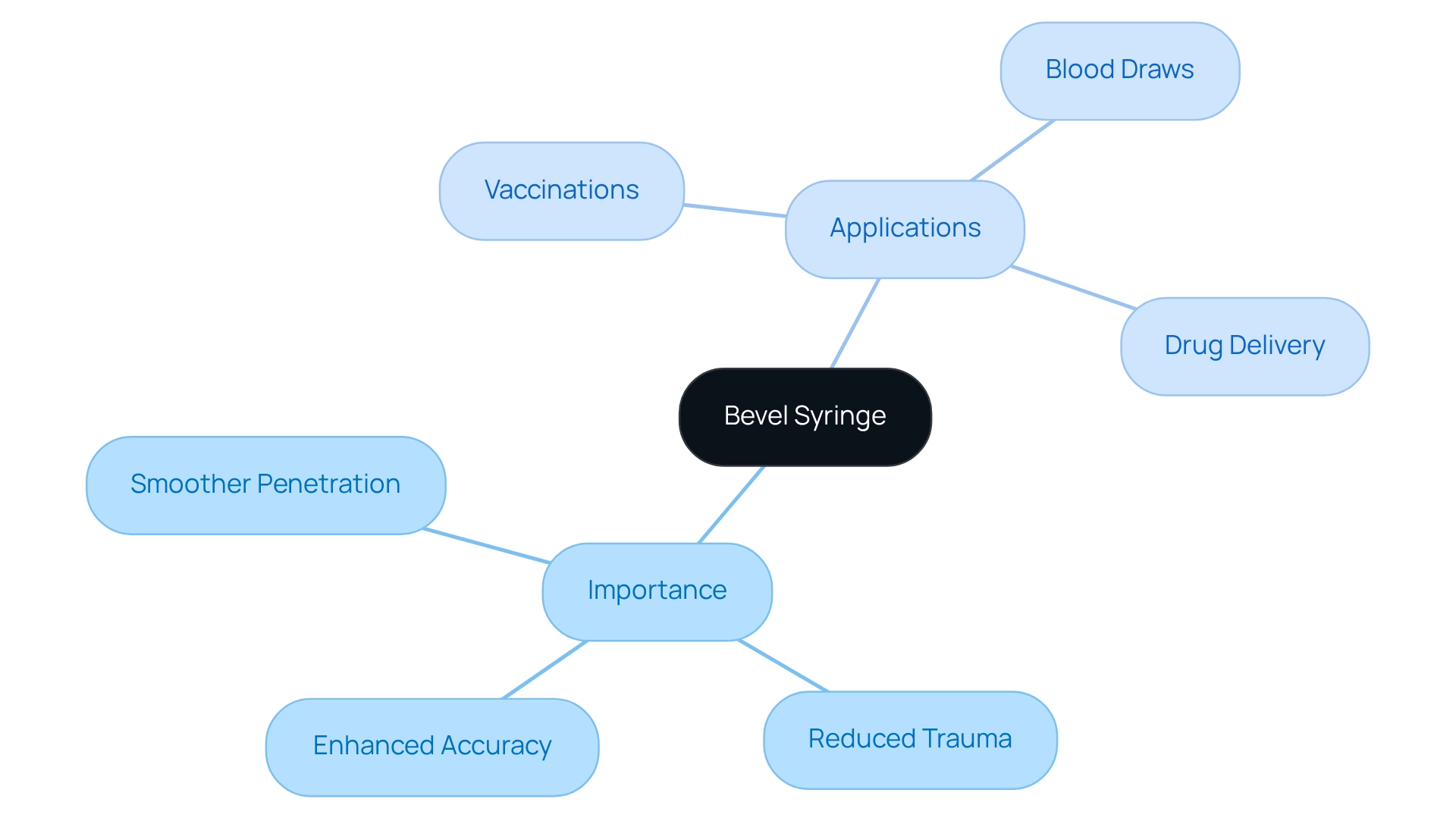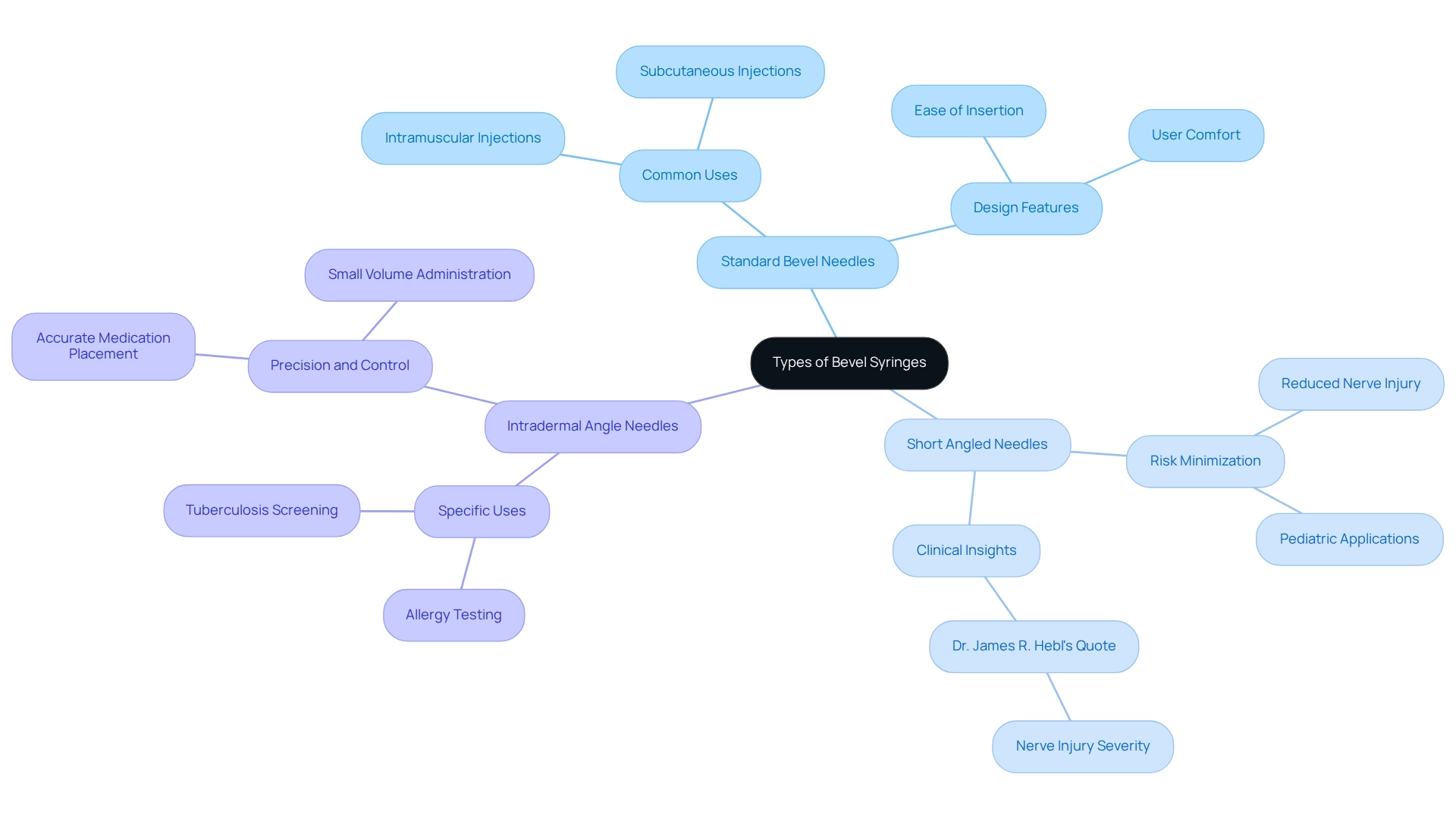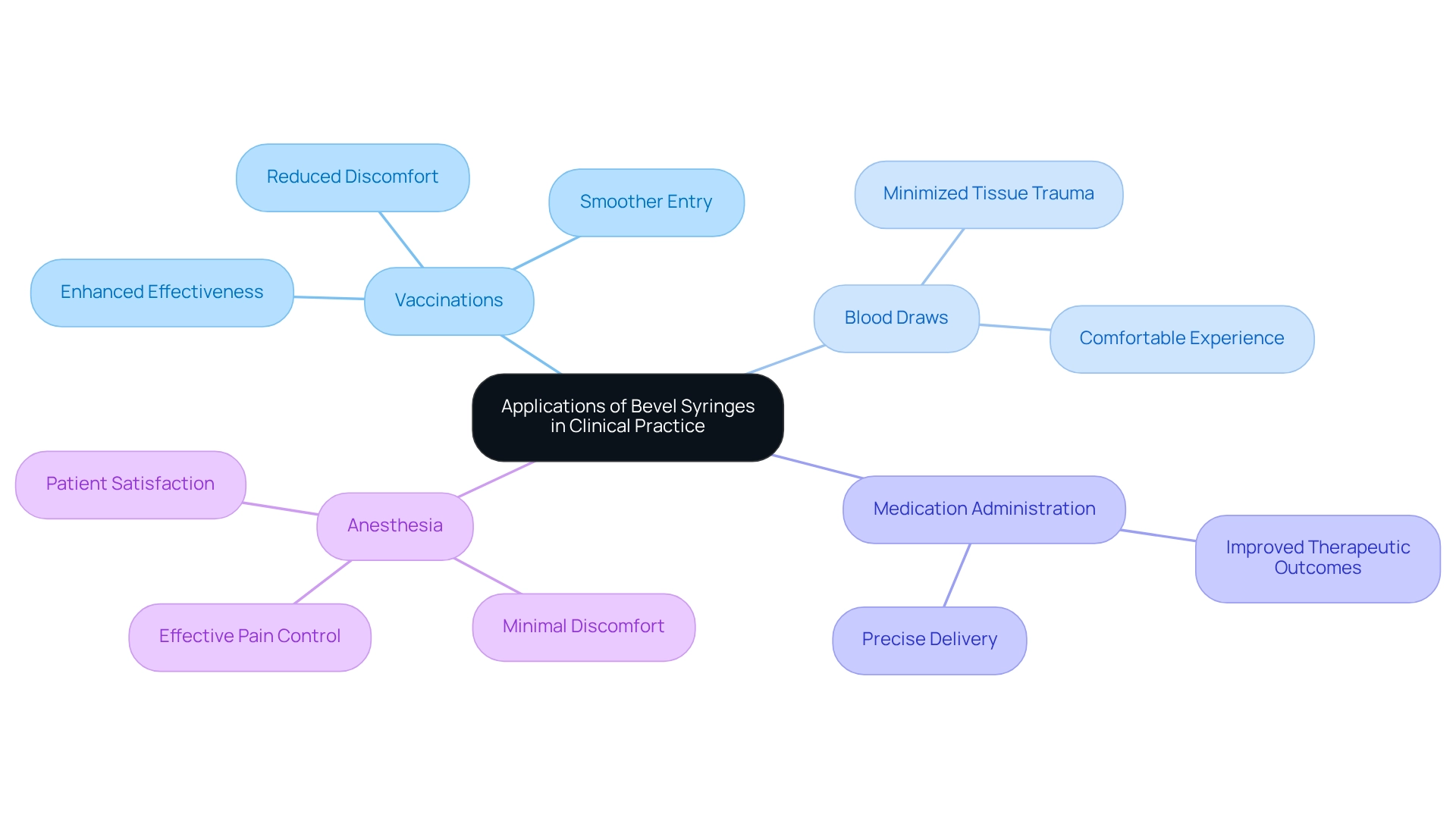Overview
This article provides a comprehensive overview of the types, applications, and best practices associated with bevel syringes in medical settings. It highlights the critical role bevel syringes play in enhancing patient comfort and procedural efficiency. Different types—such as standard, short, and intradermal—are meticulously tailored for specific medical applications, thereby improving patient outcomes and minimizing complications. Understanding these nuances is essential for healthcare professionals aiming to optimize their practices and ensure the highest standards of care.
Introduction
In the intricate realm of medical procedures, the tools employed can significantly influence patient outcomes. Bevel syringes, characterized by their uniquely angled tips, are crucial in enhancing both the comfort and effectiveness of various injections. From vaccinations to blood draws, these syringes are meticulously designed to minimize trauma and ensure precision, directly impacting the overall patient experience.
It is essential for healthcare professionals to understand the different types of bevel syringes—regular, short, and intradermal—along with their specific applications, as this knowledge optimizes treatment efficacy and safety. This exploration delves into the significance of these syringes, their applications in clinical practice, and best practices for their safe and effective use.
Define Bevel Syringe and Its Importance in Medical Applications
A slanted syringe is characterized by its needle tip, which is strategically angled to form a sharp point. This design not only facilitates smoother penetration into the skin but also significantly reduces trauma and discomfort during injections. The angle of the edge plays a crucial role in the ease of insertion and the overall experience for the individual.
In medical applications, bevel syringes are indispensable for various procedures, including:
- Vaccinations
- Blood draws
- Drug delivery
These syringes enhance accuracy and minimize tissue injury. The importance of utilizing a syringe with a tapered tip cannot be overstated; it directly influences both the comfort of individuals and the success of medical procedures.

Explore Types of Bevel Syringes: Regular, Short, and Intradermal Bevels
- Standard Bevel Needles: These devices are the most commonly employed in clinical settings, showcasing a typical angle that suits a range of procedures, including intramuscular and subcutaneous uses. Their design achieves a balance between ease of insertion and user comfort, making them a reliable choice for healthcare professionals.
- Short Angled Needles: Featuring a reduced angle, these devices are specifically designed to minimize the risk of nerve injury during procedures, which is especially crucial in delicate operations. They are frequently utilized in pediatric care, where the delicate nature of the anatomy necessitates precision and caution. Research indicates that the application of short angled needles can significantly decrease the occurrence of nerve injuries compared to standard angled needles, thereby enhancing patient safety. As noted by Dr. James R. Hebl, while short-bevel needles may lead to fewer nerve injuries overall, the severity of injuries that do occur can be comparable to those from long-bevel needles.
- Intradermal Angle Needles: Defined by a very slight edge angle, these instruments are designed for intradermal injections, such as those utilized in allergy testing or tuberculosis screening. Their design facilitates the accurate placement of medication just beneath the skin surface, ensuring reliable results. The precision provided by intradermal angled syringes is vital for effective diagnostic methods, as it enables controlled administration of small volumes of fluid.
In clinical environments, the selection of syringe type can significantly influence patient outcomes. For instance, a case study on sympathetic blockade techniques underscores the importance of using appropriate needle types to achieve effective pain management while minimizing complications. The study found that successful sympathetic blockade was often indicated by a temperature increase of 1.0°C to 1.5°C in the skin of the palm and hand, demonstrating the effectiveness of . This highlights the essential role that selecting the appropriate syringe type plays in achieving successful clinical results.
Overall, understanding the distinctions among standard, short, and intradermal needle types is crucial for healthcare professionals. Each type serves distinct purposes, and choosing the appropriate syringe can enhance both the effectiveness of treatments and the safety of patients.

Examine Applications of Bevel Syringes in Clinical Practice
Bevel syringes play a crucial role in various clinical settings, showcasing their importance in enhancing patient care and procedural efficiency.
Vaccinations: The slanted tip of angled syringes facilitates smoother entry into the skin, which significantly reduces discomfort and anxiety for individuals receiving vaccinations. This design not only improves the experience for patients but also enhances the overall effectiveness of the vaccination process.
Blood Draws: The innovative design of angled syringes minimizes tissue trauma, thereby facilitating easier blood collection. This results in a more comfortable experience for individuals, which is essential in clinical environments where patient comfort is paramount.
Medication Administration: Whether for intramuscular, subcutaneous, or intradermal injections, the use of a bevel syringe ensures precise delivery of medications. This precision is critical in improving therapeutic outcomes, as it allows healthcare professionals to administer treatments effectively and reliably.
Anesthesia: In both dental and surgical environments, angled syringes are indispensable for administering local anesthetics. Their design allows for minimal discomfort, which is vital for and patient satisfaction during procedures.
In summary, the use of angled syringes across various clinical applications not only enhances procedural efficiency but also significantly improves patient comfort and outcomes.

Implement Best Practices for Using Bevel Syringes Safely and Effectively
To ensure the safe and effective use of bevel syringes, it is imperative to adhere to the following best practices:
- Select the Suitable Syringe: Begin by choosing the correct angled syringe tailored to the specific procedure and patient needs. Key considerations include needle gauge, length, and bevel type, as these factors significantly influence the efficacy of the injection.
- Maintain Sterility: Utilizing sterile equipment is essential for preventing infections. Statistics indicate that adherence to proper sterilization protocols can substantially reduce infection rates associated with syringe use. Always follow established protocols for handling and disposing of used syringes to uphold the highest standards of hygiene.
- For optimal results, position the bevel syringe with the bevel facing up during applications. This technique facilitates smoother insertion and minimizes discomfort for individuals, aligning with best practices in clinical settings.
- Inject at the Correct Angle: Adjust the angle of insertion based on the type of administration—whether intramuscular, subcutaneous, or intradermal—to ensure accurate medication delivery. Proper angling is essential for maximizing therapeutic outcomes.
- Monitor Individual Response: After administering an injection, closely observe the individual for any adverse reactions. Promptly provide appropriate care as needed, emphasizing the significance of safety and comfort for individuals throughout the process.
As Joseph Lister, a pioneer in antiseptic surgery, stated, "The humblest individual can contribute to the advancement of medicine." By adhering to these guidelines, healthcare professionals can enhance patient care and positively impact each patient's journey, reflecting the principles established by Lister that a surgeon's legacy is defined not merely by lives saved but by on each patient's experience.
Conclusion
The significance of bevel syringes in medical practice is profound. Their uniquely angled tips facilitate smoother and more comfortable injections, ultimately enhancing patient experience and outcomes across a variety of clinical applications. From vaccinations to blood draws and medication administration, each type of bevel syringe—regular, short, and intradermal—serves distinct purposes that are crucial for effective treatment.
Understanding the differences among these syringes empowers healthcare professionals to make informed decisions that optimize patient safety and therapeutic effectiveness. The careful selection of the appropriate bevel syringe, combined with adherence to best practices for sterility and technique, directly impacts the quality of care delivered. Ensuring the correct positioning and angling during injections further minimizes discomfort and maximizes precision.
In summary, the thoughtful application of bevel syringes in clinical settings reflects a commitment to excellence in patient care. By prioritizing the use of these specialized tools, healthcare providers can significantly improve patient comfort, reduce complications, and enhance the overall effectiveness of medical procedures. As the landscape of healthcare continues to evolve, the importance of such details will remain paramount in achieving successful outcomes and fostering trust in the patient-provider relationship.




